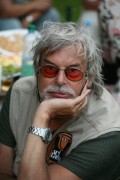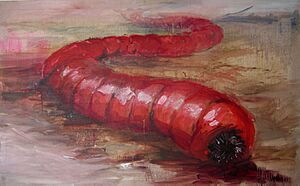Ivan Mackerle facts for kids
Quick facts for kids
Ivan Mackerle
|
|
|---|---|
 |
|
| Born | 12 March 1942 Plzeň, Protectorate of Bohemia and Moravia
|
| Died | 3 January 2013 (aged 70) Prague, Czech Republic
|
| Years active | 40 |
| Spouse(s) | Ivona Paličková |
| Children | Danny Mackerle |
| Parent(s) | Father: Julius Mackerle |
Ivan Mackerle (born March 12, 1942 – died January 3, 2013) was a famous Czech explorer, author, and engineer. He was especially known for his interest in cryptozoology. This is the study of hidden or unknown animals, like the Loch Ness monster.
Mackerle organized many exciting trips. He searched for the Loch Ness monster in Scotland. He also looked for the Tasmanian tiger in Australia. Another creature he sought was the elephant bird in Madagascar. He became most famous for his search for the mysterious Mongolian death worm. He traveled to Mongolia three times to find it. Ivan Mackerle also wrote many books and articles. From 1998 to 2002, he was the main editor of a Czech magazine called Fantastická fakta ("Fantastic Facts"), which was about strange and unexplained things.
Contents
Early Life and Interests
Ivan Mackerle was born on March 12, 1942, in Plzeň. This city was in a place then known as the Protectorate of Bohemia and Moravia. His father was a car designer. When Ivan was three, his family moved to Kopřivnice. He spent his childhood in Plzeň.
From a young age, Ivan was fascinated by legendary creatures. He was especially interested in the Mongolian death worm. He loved reading adventure books by Jaroslav Foglar. He also enjoyed children's magazines like Vpřed and Junák. These magazines were actually against the rules in communist Czechoslovakia at that time. Other writers who inspired him included Ivan Yefremov, a Russian scientist and science fiction author. He was also influenced by Charles Fort, an American who investigated unexplained events.
When he was 16, Mackerle moved to Prague. He studied mechanical engineering at the Czech Technical University in Prague. He already knew a lot about animals and electronics. After finishing his studies, Mackerle worked as a designer. He even managed a car company. But soon, he decided to focus more seriously on cryptozoology.
Adventures and Expeditions
Ivan Mackerle began exploring with his friend and former colleague, Michal Brumlik. They investigated castles in Czechoslovakia that were said to be haunted. For his trips, Mackerle bought a special German amphibious jeep. This vehicle, a Volkswagen Schwimmwagen from World War II, could travel on both land and water. He fixed it up to help with his work. He used this jeep for his explorations in Transylvania, where he searched for Count Dracula's castle.
When he was 27, Mackerle tried hard to get permission from the Czechoslovakian government. At that time, the country was behind the Iron Curtain. He wanted to go to Scotland to look for the Loch Ness Monster. During his short visit, he met another Loch Ness researcher, Robert H. Rines. Mackerle was very impressed by Rines's use of underwater cameras and sound technology.
In the 1980s, Mackerle became well-known in Czechoslovakia for his talks and shows. His presentation called Beautiful Mysteries of Our Planet was very popular. He also sold a successful book, Cesty za příšerami a dobrodružstvím ("Quests for Monsters and Adventure"). Along with his talks and newspaper articles, selling his book helped him raise money for his expeditions.
Searching for the Mongolian Death Worm

In 1989, Mackerle was at a big protest in Wenceslas Square during the Velvet Revolution. He told his friend Jiří Skupien about his dream to go to Mongolia. The very next year, in 1990, he made his first trip there. His team spent eight weeks searching for a large, dangerous, dark-red worm-like creature. People believed this creature lived in the Gobi desert. It was known as the Mongolian death worm. Mackerle thought it might look like a type of worm lizard from South America.
He described the worm based on what others told him: "It's like a sausage, over half a meter (20 inches) long. It's as thick as a man's arm and looks like an animal's intestine. Its tail is short, as if it was cut off, not pointy. It's hard to tell its head from its tail because it has no visible eyes, nose, or mouth. Its color is dark red, like blood or salami..."
Mackerle thought the worm might get its poison from the goyo plant. He also believed it could give deadly electric shocks.
In 1992, Mackerle made his second eight-week trip to Mongolia. At a Buddhist monastery, he was warned that the worm was a creature of "supernatural evil." He was told he was risking his life by searching for it. Mackerle remembered having a very clear dream about the worm. He said he woke up with strange, blood-filled boils on his back. He gathered enough photos, videos, and information to make a documentary. This film, called The Sand Monster Mystery, was shown on Czech television in 1993.
Other Explorations and Media Work
Mackerle's expeditions also included a search for man-eating "death blossoms" in Madagascar. He also went scuba diving near a Micronesian island. There, he looked for a burial place with platinum coffins. These searches were not successful.
From 1998 to 2002, he was the main editor of the Czech magazine Fantastická fakta (Fantastic Facts). He wrote about strange events and paranormal topics. He also worked as a helper for a TV series called Záhady a mystéria (Enigmas and mysteries) between 1998 and 2000.
In the early 2000s, Mackerle had heart problems. But he got better by 2004. That year, in late summer, he started his third trip to Mongolia. He explored the desert with Jiří Zítka, a pilot who flew an ultralight aircraft. They attached a video camera to the plane, but they still couldn't find the creature. Mackerle eventually thought the creature was probably a myth. He believed it might be something people imagined, or a "psychological problem" caused by the desert's extreme heat.
Personal Life
Ivan Mackerle wrote several books. He also wrote for many magazines for a long time, including the Fortean Times. In his free time, he was very interested in old military vehicles.
When he was 20, he married Ivona Paličková. They had a son named Danny. Danny often joined his father on many expeditions in the amphibious Schwimmwagen.
Death
Ivan Mackerle passed away on January 3, 2013. He had been ill for a long time. His wife, Ivona, and his son, Dan, survived him.

